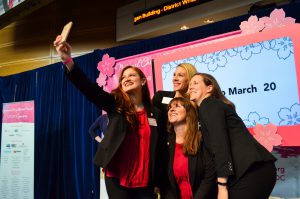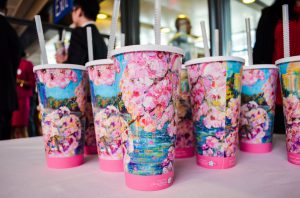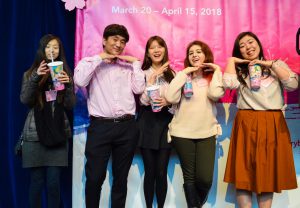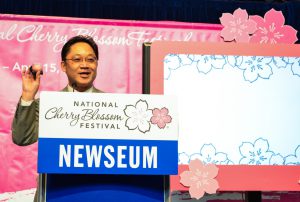WASHINGTON—This year, Washington’s famous cherry blossom bloom may come a week early—with the peak bloom expected between March 17 and March 20, five days ahead of last year’s date and following a general trend of earlier blooms that researchers say is due to a warming climate.
The 91st Annual National Cherry Blossom Festival, which begins March 20, celebrates the gift of 3,000 Japanese cherry trees from the Mayor of Tokyo to Washington in 1912.
“We should all be proud that people equate the spring with Washington, D.C. Not just here in Washington, not just the nation, but across the globe,” said Washington Mayor Muriel Bowser at a press conference Thursday at the Newseum. “It really is a rebirth for all of us.”
The festival—which is expected to welcome 1.5 million visitors —will feature a month of events around the city, including concerts, a Japanese street festival and a parade on April 14.
Crowded into the Newseum, attendees were the first to hear the dates of the peak cherry blossom bloom, during which 70 percent of the blossoms will open and bathe the Tidal Basin in a sea of pink for weeks.
Last year’s peak began March 25, setting this year’s prediction a week apart. Mike Litterst, a spokesman for the National Parks Service—which tends to the cherry trees—said predicting the peak is no simple task. NPS experts rely on historical data and careful observation of the trees in order to make their prediction.
“The trees go through six stages on the way to peak bloom,” Litterst said. “Last year and this year we hit that first stage only a day apart, so there is no correlation between when that process starts and when we hit peak bloom.”
The first stage, in which small green buds first appear on the barren tree branches, was reached on Feb. 25, the fifth-earliest date in 27 years.
In 2016, a video from the NPS discussed data showing that Washington has undergone an increase in temperature at a rate of 1.6 degrees-per-century, and noted that heat signals the end of winter to flowering trees and initiates the blooming process.
Meanwhile, researchers in Japan, who have tracked the dates of the cherry blossom bloom since 800 A.D. found that in the last 200 years the date of the bloom in Kyoto has advanced around seven days, correlating with an average temperature increase of 6.1 degrees.
The primary gift of 3,000 cherry trees in 12 varieties has now expanded to 3,700, but many of the originals have been replaced due to their short lifespan.
Takehiro Shimada, the minister of communications and cultural affairs at the Japanese Embassy and Diane Mayhew, president of the National Cherry Blossom Festival, emphasized the friendship between Japan and the U.S. that the festival represents.
“What started with a gift of trees, now is the nation’s greatest springtime celebration,” Mayhew said. “So those 3,000 cherry trees given as a gift in 1912 by the mayor of Tokyo to Washington D.C. is the roots of the festival expressing friendship and peace. It’s a great message that the world needs to be reminded of.”









